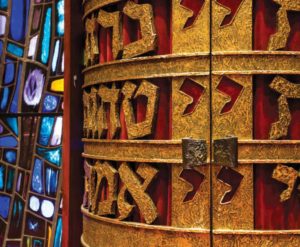
Memory and identity are intertwined in Judaism, and liturgical practices play an integral part in perpetuating Jewish memory and reinforcing communal identity. This distinctive of Jewish worship is ingrained in the architecture of the sanctuary at Temple Beth Am in Los Angeles, California. At the focal point of the image in the center frame stands a modern stained glass depiction of the burning bush cresting the top of the ark of the covenant. As the community gathers the Torah scrolls are taken from the ark of the covenant and read aloud. In this act of worship the community enters into sacramental time and stands at the foot of Sinai receiving the law of God from Moses.
On both sides of the sanctuary, stone walls stretch from floor to ceiling. On the right is mounted a light with seven fixtures symbolizing the Menorah and surrounded with engraved symbols and Hebrew phrases that name the numerous gifts of God to the Jewish community throughout its history. Among these gifts are the annual harvests and Jewish festivals, the Law and commandments. Juxtaposed with this wall, on the left of the ark hangs a light made of gnarled metal and prison wire with six fixtures representing the six million Jews killed during the Holocaust. The wall is filled with the major losses and laments of the Jewish community including the Shoah, medieval pogroms, and the destruction of the Second Temple.
The architecture of Temple Beth Am is no mere religious ornamentation. Those inhabiting this sacred space on a regular basis are ushered into an act of worship of God with eyes wide open. As Rabbi David Wolpe once put it, “To the extent that faith ignores the world, or filters out the uncomfortable bits, it is weakened and impoverished.”1 Reception of the Law of God is to be done amidst the rehearsal of the community’s joyous gifts and painful losses. It is in this context that Jewish identity is forged through memory in worship.
1Rabbi David J. Wolpe, The Healer of Shattered Hearts: A Jewish View of God (New York: Penguin Books, 1990), 8.

